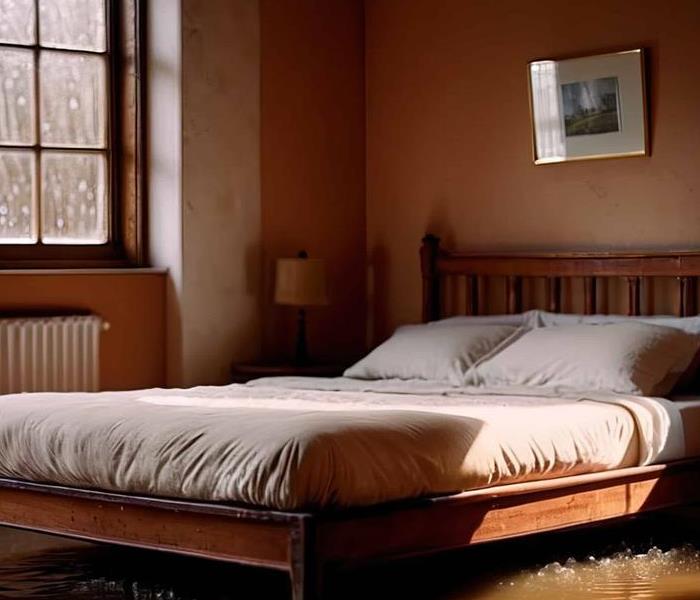Ice Dams: How They Can Cause Water Damage to Homes in Winter
10/3/2024 (Permalink)
Winter in Portland brings the usual mix of rain, snow, and freezing temperatures. While snow can create picturesque scenes, it can also lead to hidden dangers for homeowners, especially when it comes to ice dams. Ice dams are a common winter problem that can cause significant water damage to your home if not properly addressed. SERVPRO of NW Portland is here to help you understand the dangers of ice dams and how to prevent water damage.
What Are Ice Dams?
An ice dam is a ridge of ice that forms along the edge of a roof, preventing melted snow from properly draining off. When snow accumulates on your roof and starts to melt due to rising temperatures or heat escaping from your attic, the water can flow down toward the colder edges of your roof. As it reaches these colder areas, the water refreezes, creating an ice barrier or dam.
Once the ice dam forms, any additional melted snow has nowhere to go, causing water to back up behind the dam. This trapped water can seep underneath shingles and into your home, leading to water damage in the walls, ceilings, insulation, and more.
How Ice Dams Cause Water Damage
Ice dams may appear harmless, but they can lead to severe water damage in several ways:
Leaking Roof: The most immediate danger is water seeping through your roof. As the ice dam prevents proper drainage, water backs up and infiltrates roofing materials. This can cause leaks inside your home, damaging ceilings, walls, and insulation.
Interior Water Damage: Once water enters your home, it can damage drywall, wood framing, and other structural elements. Over time, this moisture can weaken these materials, leading to costly repairs.
Mold Growth: Water trapped in your home’s walls and insulation can create a perfect environment for mold growth. Mold not only damages your home but can also pose health risks to your family.
Gutter Damage: The weight of ice dams can cause your gutters to become dislodged or damaged. Broken gutters prevent proper water drainage and can further contribute to water damage around your home’s foundation.
Preventing Ice Dams
Preventing ice dams before they form is key to avoiding water damage. Here are some steps you can take:
Proper Insulation: One of the most effective ways to prevent ice dams is by ensuring your attic is properly insulated. This helps prevent heat from escaping through the roof, keeping the surface cold and minimizing snow melt.
Roof Ventilation: Adequate roof ventilation helps maintain a consistent temperature across the roof, preventing snow from melting unevenly. A well-ventilated attic allows cold air to circulate, reducing the chances of ice dams forming.
Remove Snow Safely: If you experience heavy snowfalls, use a roof rake to safely remove snow from the edges of your roof. This reduces the amount of snow that can melt and refreeze, helping to prevent ice dams.
Seal Air Leaks: Seal any gaps or cracks in your attic or around your roof that may allow warm air to escape. This includes checking for leaks around vents, chimneys, and other openings.
Heated Cables: In some cases, homeowners may install heated cables along the edge of the roof to help melt snow and prevent ice dams from forming. However, this solution should be used with caution and proper installation.
What to Do If You Have an Ice Dam
If you already have an ice dam, taking quick action is crucial to prevent water damage:
Safely Remove Snow: If it’s safe to do so, use a roof rake to clear snow from the roof's edge. This helps to minimize additional water buildup behind the ice dam.
Call a Professional: Removing an ice dam can be dangerous if not done properly. It’s best to call a professional who can safely remove the ice and snow using specialized equipment.
Address Water Damage Immediately: If water has already seeped into your home, it’s essential to address the damage as soon as possible. SERVPRO of NW Portland provides emergency water damage restoration services to mitigate the damage and prevent mold growth.
How SERVPRO of NW Portland Can Help
If an ice dam has caused water damage in your home, SERVPRO of NW Portland is here to help with our water damage restoration services:
24/7 Emergency Response: We are available around the clock to respond to water damage emergencies, helping you mitigate the damage quickly.
Water Removal and Drying: We use advanced water extraction and drying equipment to remove moisture from your home, preventing further damage.
Mold Remediation: Our certified professionals can assess and address any mold growth caused by water infiltration, ensuring your home is safe and healthy.
Restoration and Repairs: From minor repairs to major reconstruction, we handle every step of the restoration process, getting your home back to its pre-damage condition.
Conclusion
Ice dams may seem like a minor winter nuisance, but they can lead to significant water damage if left unaddressed. By taking preventative steps and acting quickly if an ice dam forms, you can protect your home from costly damage. If you experience water damage due to an ice dam, SERVPRO of NW Portland is ready to assist with fast, professional restoration services. Don’t let winter weather ruin your home—contact us today to learn how we can help.

 24/7 Emergency Service
24/7 Emergency Service
